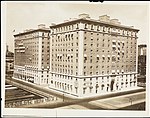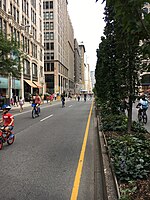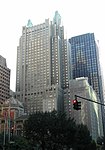270 Park Avenue (1960–2021)

270 Park Avenue, also the JPMorgan Chase Tower and Union Carbide Building, was a skyscraper in the Midtown Manhattan neighborhood of New York City. Built in 1960 for chemical company Union Carbide, it was designed by architects Gordon Bunshaft and Natalie de Blois of Skidmore, Owings & Merrill (SOM). The 52-story, 707-foot (215 m) skyscraper was the global headquarters for JPMorgan Chase prior to its demolition in 2021. The Union Carbide Building was the tallest peacefully demolished building in the world upon its destruction. A taller skyscraper with the same address, to be completed in 2025, is being constructed on the site. The building occupied a full city block bounded by Madison Avenue, 48th Street, Park Avenue, and 47th Street and was composed of two sections. The main shaft, facing east toward Park Avenue, was 52 stories tall. There was a 12-story annex facing west toward Madison Avenue. About two-thirds of 270 Park Avenue was built atop two levels of underground railroad tracks, which feed directly into Grand Central Terminal to the south. This not only prevented a basement from being built under most of the site but also required that the lobby be one story above ground level. Union Carbide's offices were designed around a grid of 5-by-5-foot (1.5 by 1.5 m) modules. The offices contained flexible furnishings and partitions, as well as a luminous ceilings. The Union Carbide Building received mixed criticism during its existence. The site had been occupied by the Hotel Marguery from 1917 to 1957. Union Carbide leased the land from New York Central Railroad (later Penn Central) and announced plans for the building in 1955. Union Carbide moved into its headquarters in 1960 and acquired the underlying land in 1976 after Penn Central went bankrupt. After three years of negotiations, Union Carbide agreed in 1978 to sell the building to Manufacturers Hanover Corporation. Manufacturers Hanover moved into 270 Park Avenue in 1980 and renovated the building. Through several mergers, Manufacturers Hanover became part of JPMorgan Chase. The bank announced plans to demolish the building in 2018. Despite preservationists' objections, the Union Carbide Building was demolished from 2019 to 2021.
Excerpt from the Wikipedia article 270 Park Avenue (1960–2021) (License: CC BY-SA 3.0, Authors, Images).270 Park Avenue (1960–2021)
East Helmsley Walk, New York Manhattan
Geographical coordinates (GPS) Address Nearby Places Show on map
Geographical coordinates (GPS)
| Latitude | Longitude |
|---|---|
| N 40.7558 ° | E -73.9754 ° |
Address
Grand Central Terminal
East Helmsley Walk
10169 New York, Manhattan
New York, United States
Open on Google Maps









